 W
WSaint Austol was a 6th-century Cornish holy man who lived much of his life in Brittany.
 W
WSaint Brioc was a 5th-century Welsh holy man who became the first abbot of Saint-Brieuc in Brittany. He is one of the seven founder saints of Brittany.
 W
WSaint Carantoc, also anglicized as Carantock, Carannog and by other spellings, was a 6th-century abbot, confessor, and saint in Wales and the West Country. He is credited with founding Llangrannog, Ceredigion, Wales and St Carantoc's Church, Crantock. His name is listed amongst the Cornish Saints. Carantoc's is one of five insular saints' lives and two Breton ones that mention Arthur in contexts that may be independent of Geoffrey of Monmouth's Historia Regum Britanniae. He is venerated by the Orthodox Church and Roman Catholic Church.
 W
WColumba of Cornwall, also called Columb (English), was a saint from Cornwall who lived in the 6th century. She was born to pagan royalty, but became a Christian after the Holy Spirit, in the form of a dove, appeared to her in a vision. Her parents arranged a marriage to a pagan prince, but she refused the marriage and they imprisoned her. She escaped to Cornwall, where she was again captured and martyred. She is the patron of two churches in Cornwall, in St Columba Major and St Columba Minor, where well-developed traditions arose about her. The traditions include a tale about a spring gushing forth along the path of her blood at the site of her execution and another about a well at the site containing water that would not boil. Various dates in November have been cited as her feast day.
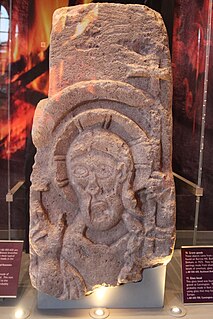 W
WSaint Congar, was a Welsh abbot and supposed bishop in Somerset, then in the British kingdom of Somerset, now in England.
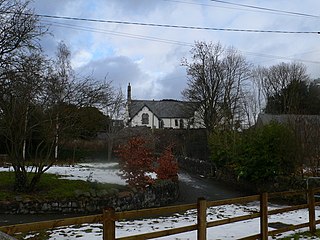 W
WDigain was a 5th-century Welsh saint and Prince of Dumnonia.
 W
WSaint Endelienta was a Cornish saint of the 5th and 6th century. She is believed to be a daughter of the Welsh King Brychan, and a native of South Wales who travelled to North Cornwall to join her siblings in converting the locals to Christianity. Legend says that she was a goddaughter of King Arthur, and that she lived as a hermit at Trentinney where she subsisted on the milk of a cow. The saint is commemorated in the church and village of St Endellion which bear her name; Endellion being an Anglicised version of her name. Her feast day is 29 April.
 W
WSaint Enoder, was a 5th century Cornish saint from Brecknockshire in South Wales. He is venerated in the Anglican and Roman Catholic Churches.
 W
WSaint Enodoc, originally Wenedoc, was a sub-Roman Pre-congregational saint of Cornwall.
 W
WGerrans is a coastal civil parish and village on the Roseland Peninsula in Cornwall, England, United Kingdom. The village adjoins Portscatho on the east side of the peninsula. The village is situated approximately seven miles (11 km) south-southeast of Truro.
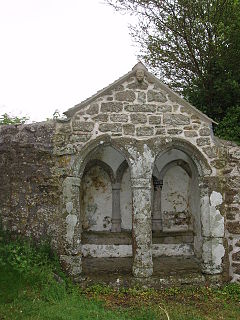 W
WSaint Germochus or Germoe was an early 6th century saint active in Cornwall and Brittany.
 W
WSaint Gwinear was a Celtic martyr, one of only two early Cornish saints whose biographies survived the Reformation. The Life of Gwinear was written in the early 14th century by a priest named Anselm, and has sometimes been printed among Saint Anselm's works. His feast day is March 23.
 W
WSaint Julitta, or Saint Juliot, is a male Celtic saint to whom two Cornish churches are dedicated. He is believed to have settled at the site of Tintagel Castle at the end of the 5th century and established a small monastic community. In some accounts he is a member of the Children of Brychan and St Nectan and the holy female Hermit, St Keyne, are thought to have been his companions. He is the patron of the parish churches of St Juliot and of Lanteglos by Camelford. The Norman chapel of Tintagel Castle is dedicated to St Julitta. At Jetwells near Camelford is a holy well. Jetwells derives from "Juliot's well".
 W
WKeyne was a 5th-century holy woman and hermitess who was said to have traveled widely through what is now South Wales and Cornwall.
 W
WMabyn, also known as Mabena, Mabon, etc., was a medieval Cornish saint. According to local Cornish tradition she was one of the many children of Brychan, king of Brycheiniog in Wales in the 5th century. The village and civil parish of St Mabyn is named for her, and the local St Mabyn Parish Church is dedicated to her.
 W
WSt Marnarck also known as Manaccus was a bishop who became the patron saint of Lanreath. According to William Worcester his body lay in the church of Lanreath. He is commemorated in one of the stained glass windows of St Neot parish church. His feast day is 3 August.
 W
WSaint Melaine was a 6th-century Bishop of Rennes in Brittany.
 W
WMelor was a 10th-century Breton saint who, in England, was venerated in Cornwall and at Amesbury Abbey, Wiltshire, which claimed some of his relics.
 W
WMenefrida is the 5th-century Cornish saint associated with the parish of St Minver, near the Camel estuary in Cornwall, England. Alternative spellings of her name include Menefreda, Menwreda, Menfre, Mynfreda and Minefreda. At the time of King Henry VIII the parish was known as St. Menifryde.
 W
WMorwenna is the eponymous patron saint of Morwenstow, a civil parish and village in north Cornwall, UK. Her name is thought to be cognate with Welsh morwyn "maiden", although the first name is also used in Brittany and said to be composed of "Mor" and "Gwenn", meaning "White sea" in breton.
 W
WNeot is a saint. He was born in the first half of the ninth century, and he lived as a monk at Glastonbury Abbey. He preferred to perform his religious devotions privately, and he later went to live an isolated life in Cornwall, near the village now called St Neot. His wisdom and religious dedication earned him admiration from the monks. He visited the Pope in Rome and the Pope instructed him to found a monastery in Cornwall.
 W
WSaint Noyale, also known as Noaluen, was a semi-legendary 5th-century Celtic saint, cephalophore, and virgin martyr. She is a popular saint in both Brittany and Cornwall, where she is memorialized at Newlyn East. According to legend, it is there that a fig tree growing from the south wall of the church grew from Noyale's staff. A holy well nearby was the site of her martyrdom. She was one of numerous Celtic settlers who travelled to Brittany during the Anglo-Saxon invasion of England.
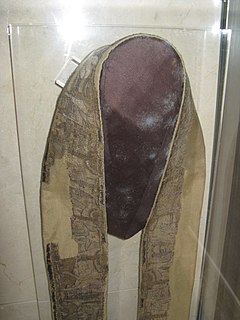 W
WPaul Aurelian was a 6th-century Welshman who became first bishop of the See of Léon and one of the seven founder saints of Brittany. He allegedly died in 575, rumoured to have lived to the age of 140, after having been assisted in his labors by three successive coadjutors. This suggests that several Pauls have been conflated. Gilbert Hunter Doble thought that he might have been Saint Paulinus of Wales.
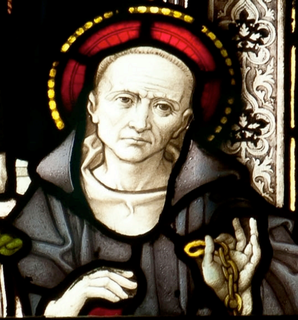 W
WSaint Petroc or Petrock was a British prince and Christian saint.
 W
WSaint Piran or Pyran, died c. 480, was a 5th-century Cornish abbot and saint, of Irish origin. He is the patron saint of tin-miners, and is also generally regarded as the patron saint of Cornwall, although Saint Michael and Saint Petroc also have some claim to this title.
 W
WSaint Senara is a legendary Cornish saint with links to the village of Zennor on the north coast of Cornwall , UK. The Church of Saint Senara, Zennor is dedicated to her; the village, nearby headland Zennor Head, and the neolithic tomb Zennor Quoit received her name indirectly.
 W
WSaint Sithney was a sub-Roman Celtic saint active in Cornwall and Brittany. He is the patron saint of mad dogs.
 W
WTetha, also known as Teath, Tecla, and by a variety of other names, was a 5th-century virgin and saint in Wales and Cornwall. She is associated with the parish church of St Teath in Cornwall. Baring-Gould gives her feast day as 27 October, but this has been called a mistaken conflation with Saint Ia. In 1878, it was held on the movable feast of Whit Tuesday. Other sources place it on 1 May, 6 September, and (mistakenly) 15 January. It is no longer observed by either the Anglican or Catholic church in Wales.
 W
WTudy of Landevennec was a Breton saint of the 5th or 6th century. He was a hermit who founded monasteries at Landévennec in Brittany, France and in Cornwall, England. The village of St Tudy in Cornwall is named for him. He may have been a disciple of Saint Maudez, after whom St Mawes is named. His companions may have included Saint Corentinus and Saint Brioc. Île-Tudy, on the mouth of the Odet, is named after him.
 W
WSaint Veep is the Cornish saint for whom the village and parish of St Veep were named.
 W
WSaint Wenna is a Cornish saint and the dedicatee of several churches, venerated in the Eastern Orthodox Church, Roman Catholic Church, and Anglican Communion. Her feast day is 18 October.
 W
WWilgyth of Cholsey was a 6th-century Catholic female saint from Anglo-Saxon England who was venerated locally in Berkshire.
 W
WSaint Winwaloe was the founder and first abbot of Landévennec Abbey, also known as the Monastery of Winwaloe. It was just south of Brest in Brittany, now part of France.